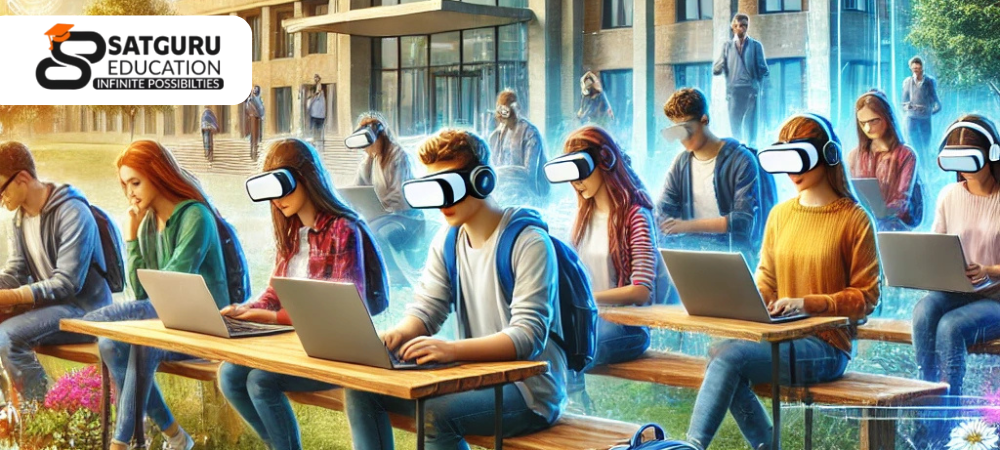In the era of globalization, the demand for quality education that transcends geographical boundaries has surged. For international students, technology has become a cornerstone in facilitating access to global learning resources, personalized education, and meaningful cultural exchanges. From virtual classrooms to AI-powered learning tools, the integration of technology in education has opened new avenues for international students to thrive academically and socially. This blog delves into how technology enhances international student learning and why it is indispensable in the modern educational landscape.
Bridging Geographic and Cultural Gaps
For international students, studying abroad often means adjusting to a new cultural and academic environment. Technology plays a critical role in easing this transition:
- Virtual Classrooms and Online Courses: Platforms like Zoom, Microsoft Teams, and Google Meet enable international students to access high-quality education without the need to relocate. Online courses from institutions like Coursera, edX, and Khan Academy offer diverse subjects, allowing students to explore areas of interest regardless of their geographical location.
- Language Learning Tools: Adjusting to a new language can be daunting. Apps like Duolingo, Babbel, and Rosetta Stone help students improve language skills through interactive lessons and gamified learning experiences. These tools empower students to communicate effectively, boosting their confidence in academic and social settings.
- Cultural Adaptation Apps: Applications like Meetup and InterNations connect international students with local communities, fostering cross-cultural understanding and integration.
Personalized Learning Experiences
One of the significant advantages of technology is its ability to offer personalized learning experiences tailored to individual needs:
- Adaptive Learning Platforms: Tools like Knewton and DreamBox use AI to analyze a student’s learning patterns and provide customized educational content. For international students, this means addressing gaps in knowledge and offering support in specific areas of difficulty.
- AI-Powered Tutors: Virtual assistants like ChatGPT and ScribeSense guide students through complex topics, providing instant feedback and explanations. This personalized attention can be especially beneficial for students who might feel hesitant to ask questions in traditional classroom settings.
- Gamification in Education: Platforms like Kahoot! and Quizlet turn learning into an engaging experience by incorporating elements of gaming. This approach is particularly effective in maintaining motivation and interest among students.
Enhanced Access to Global Resources
Technology provides international students with unparalleled access to global academic resources:
- Digital Libraries and Research Databases: Platforms like JSTOR, Google Scholar, and ProQuest offer access to thousands of academic papers, journals, and books. International students can now conduct extensive research from anywhere in the world.
- Virtual Reality (VR) in Education: VR tools like zSpace and Nearpod allow students to explore historical landmarks, conduct virtual lab experiments, and experience immersive learning environments. Such technologies make learning more interactive and impactful.
- Massive Open Online Courses (MOOCs): MOOCs from institutions like MIT, Harvard, and Stanford provide international students with opportunities to learn from world-renowned educators, often at little or no cost.
Facilitating Collaboration and Communication
Technology fosters collaboration and communication among students, educators, and peers worldwide:
- Collaborative Tools: Platforms like Slack, Trello, and Asana enable international students to work on group projects seamlessly, regardless of their physical location. These tools enhance teamwork and project management skills.
- Global Networking Opportunities: Social media platforms like LinkedIn and academic forums allow students to connect with professionals, alumni, and peers, building valuable networks that can benefit their academic and career aspirations.
- Cross-Cultural Collaboration: International students can participate in global initiatives and projects, gaining diverse perspectives and enhancing their problem-solving skills.
Overcoming Challenges with Technological Solutions
Despite its numerous benefits, international students often face challenges such as homesickness, financial constraints, and academic stress. Technology offers solutions to address these issues:
- Mental Health Apps: Tools like Calm, Headspace, and Talkspace provide mental health support through guided meditations, counseling, and stress management techniques.
- Financial Planning Tools: Apps like Mint and PocketGuard help students manage their finances effectively, ensuring they can focus on their studies without unnecessary financial stress.
- Time Management Applications: Tools like Notion and Todoist enable students to organize their schedules and meet academic deadlines efficiently.
Challenges of Technology Integration
While the role of technology in education is transformative, it is not without challenges:
- Digital Divide: Access to technology is still limited in certain parts of the world. International students from underprivileged backgrounds may struggle to access necessary devices and stable internet connections.
- Cybersecurity and Privacy Concerns: With the increasing use of online platforms, students are at risk of data breaches and privacy violations. Institutions must prioritize cybersecurity measures to protect sensitive information.
- Over-Reliance on Technology: Excessive dependence on technology can lead to reduced critical thinking and problem-solving abilities. It’s crucial to balance technological and traditional learning methods.
The Future of Technology in International Education
As technology continues to evolve, its role in enhancing international student learning will only expand. Emerging trends include:
- Artificial Intelligence (AI) and Machine Learning (ML): AI-powered tools will further personalize education, predicting student needs and optimizing learning pathways.
- Blockchain for Credential Verification: Blockchain technology can ensure secure and transparent verification of academic credentials, simplifying the application and transfer processes for international students.
- Augmented Reality (AR) and Virtual Reality (VR): AR and VR will make education more immersive, offering virtual internships, simulations, and real-world problem-solving scenarios.
- 5G Technology: Faster and more reliable internet will enable seamless connectivity, improving the quality of online education and virtual collaborations.
Conclusion
Technology has undeniably revolutionized the way international students learn and adapt to new academic environments. From personalized learning tools to global collaboration platforms, technology empowers students to overcome barriers and excel in their educational journeys. However, it is equally important to address the challenges of technology integration to ensure equitable access and responsible use.
As educators and institutions continue to embrace technological innovations, they must prioritize inclusivity, security, and a balanced approach to learning. By doing so, they can harness the full potential of technology to create enriching and impactful educational experiences for international students worldwide.






